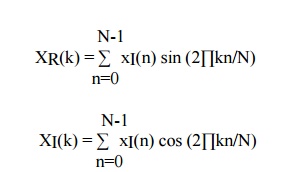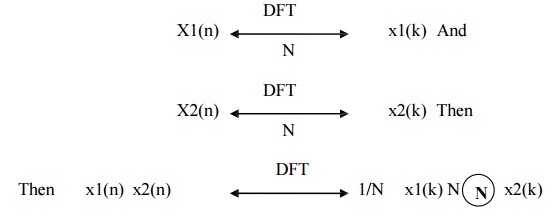Chapter: Digital Signal Processing : Frequency Transformations
Properties of Discrete Fourier Transform(DFT)
PROPERTIES OF DFT

1. Periodicity
Let x(n) and x(k) be the DFT pair then if
x(n+N) = x(n) for
all n then
X(k+N) = X(k) for
all k
Thus periodic sequence xp(n) can be given as

2. Linearity
The linearity property states that if

DFT of linear combination of two or more signals is
equal to the same linear combination of DFT of individual signals.
3. Circular Symmetries of a sequence
B) A sequence is said to be circularly odd if it is anti symmetric about the point zero on the circle. Thus X(N-n) = - x(n)
C) A circularly folded sequence is represented as x((-n))N and given by x((-n))N = x(N-n).
D) Anticlockwise direction gives delayed sequence and clockwise direction gives advance sequence.
Thus delayed or advances sequence x`(n) is related to x(n) by the circular shift.
4. Symmetry Property of a sequence
![]()
A. Symmetry property for real valued x(n) i.e xI(n)=0
This property states that if x(n) is real then X(N-k) = X*(k)=X(-k)
B) Real
and even sequence x(n) i.e xI(n)=0 & XI(K)=0
This property states that if the sequence is real
and even x(n)= x(N-n) then DFT becomes N-1

C) Real
and odd sequence x(n) i.e xI(n)=0 & XR(K)=0
This property states that if the sequence is real
and odd x(n)=-x(N-n) then DFT becomes N-1

D) Pure
Imaginary x(n) i.e xR(n)=0
This property states that if the sequence is purely
imaginary x(n)=j XI(n) then DFT becomes

5. Circular Convolution
The
Circular Convolution property states that if

It means
that circular convolution of x1(n) & x2(n) is equal to multiplication of
their DFT s. Thus circular convolution of two periodic discrete signal with
period N is given by

Multiplication
of two sequences in time domain is called as Linear convolution while
Multiplication of two sequences in frequency domain is called as circular
convolution. Results of both are totally different but are related with each
other.
There are two
different methods are used to calculate circular convolution
Graphical
representation form
Matrix approach
DIFFERENCE BETWEEN LINEAR
CONVOLUTION & CIRCULAR CONVOLUTION

Linear Convolution
1. In
case of convolution two signal sequences input signal x(n) and impulse response
h(n) given by the same system, output y(n) is calculated
2. Multiplication
of two sequences in time domain is called as Linear convolution
3. Linear
Convolution is given by the equation y(n) = x(n) * h(n) & calculated as

4. Linear
Convolution of two signals returns N-1 elements where N is sum of elements in
both sequences.
Circular Convolution
1. Multiplication
of two DFT s is called as circular convolution.
2. Multiplication of
two sequences in frequency domain
is called as circular convolution.
3. Circular
Convolution is calculated as

4. Circular
convolution returns same number of elements that of two signals.
Q) The two
sequences x1(n)={2,1,2,1} & x2(n)={1,2,3,4}. Find out the sequence x3(m)
which is equal to circular convolution of two sequences. Ans:
X3(m)={14,16,14,16}
Q)
x1(n)={1,1,1,1,-1,-1,- 1,-1} & x2(n)={0,1,2,3,4,3,2,1}. Find out the
sequence x3(m) which is equal to circular convolution of two sequences. Ans:
X3(m)={-4,-8,-8,-4,4,8,8,4}
Q) Perform
Linear Convolution of x(n)={1,2} & h(n)={2,1} using DFT & IDFT.
Q) Perform
Linear Convolution of x(n)={1,2,2,1} & h(n)={1,2,3} using 8 Pt DFT &
IDFT.
DIFFERENCE BETWEEN LINEAR
CONVOLUTION & CIRCULAR CONVOLUTION


6. Multiplication
The
Multiplication property states that if

It means
that multiplication of two sequences in time domain results in circular
convolution of their DFT s in frequency domain.
7. Time
reversal of a sequence
The Time
reversal property states that if

It means
that the sequence is circularly folded its DFT is also circularly folded.
8. Circular
Time shift
The
Circular Time shift states that if

Thus
shifting the sequence circularly by „l
samples is equivalent to multiplying its DFT by e –j2 ∏ k l / N
9. Circular
frequency shift
The
Circular frequency shift states that if

Thus
shifting the frequency components of DFT circularly is equivalent to
multiplying its time domain sequence by e –j2 ∏ k l / N
10. Complex
conjugate property
The Complex conjugate property states that if

11.
Circular
Correlation
The
Complex correlation property states

Here
rxy(l) is circular cross correlation which is given as

This
means multiplication of DFT of one sequence and conjugate DFT of another
sequence is equivalent to circular cross-correlation of these sequences in time
domain.
12.Parseval’sTheorem
The
Parseval s theorem states

This equation give
energy of finite duration sequence in terms of its frequency components.
Related Topics